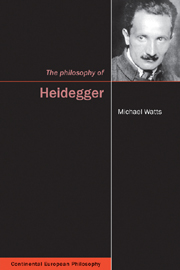Book contents
- Frontmatter
- Contents
- Preface
- Abbreviations
- 1 Heidegger's life
- 2 The meaning of life: the question of Being
- 3 The central ideas in Being and Time
- 4 Conscience, guilt and authenticity
- 5 Being-towards-death
- 6 Dasein's primordial temporality
- 7 The “truth of alētheia” and language
- 8 Heidegger on poetry, poets and Hölderlin
- 9 Heidegger on art
- 10 Heidegger on technology
- 11 Tao, Zen and Heidegger
- 12 Heidegger's politics
- Glossary
- Further reading
- Bibliography
- Index
6 - Dasein's primordial temporality
- Frontmatter
- Contents
- Preface
- Abbreviations
- 1 Heidegger's life
- 2 The meaning of life: the question of Being
- 3 The central ideas in Being and Time
- 4 Conscience, guilt and authenticity
- 5 Being-towards-death
- 6 Dasein's primordial temporality
- 7 The “truth of alētheia” and language
- 8 Heidegger on poetry, poets and Hölderlin
- 9 Heidegger on art
- 10 Heidegger on technology
- 11 Tao, Zen and Heidegger
- 12 Heidegger's politics
- Glossary
- Further reading
- Bibliography
- Index
Summary
Our treatment of the question of the meaning of Being must enable us to show that the central problematic of all ontology is rooted in the phenomenon of time, if rightly seen and rightly explained, and we must show how this is the case.
(BT: 40)From Heidegger's analysis of human existence it soon becomes clear that, in order to develop a deeper understanding of Being, to answer the question “What does it mean to be?”, we must go beyond Dasein's various modes of existence to the ultimate reference point by which these modes have meaning. In Being and Time, the central issue of the entire work (as its title suggests) is to show that, for a human being, for Dasein, “to be” is always “to be temporal”, since temporality makes up the primordial meaning of Dasein's Being. Thus our provisional aim is the interpretation of time as the possible horizon for any understanding whatever of Being. “Time must be brought to light – and genuinely conceived – as the horizon for all understanding of Being and for any way of interpreting it … and in terms of temporality as the Being of Dasein, which understands Being” (BT: 39). For if Dasein's sense of what it means to be is indeed temporal, this suggests that the appropriate horizon or context for understanding Being must be time; in other words, it is Dasein's temporality that makes Being accessible to us.
- Type
- Chapter
- Information
- The Philosophy of Heidegger , pp. 116 - 140Publisher: Acumen PublishingPrint publication year: 2011

